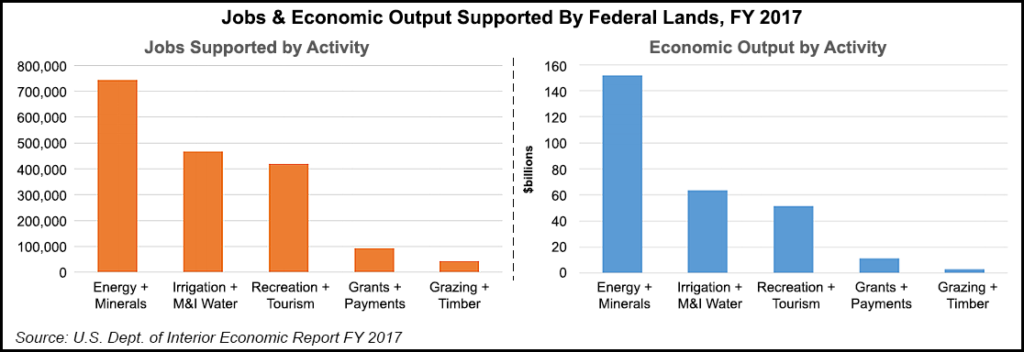Regulatory | E&P | NGI All News Access | NGI The Weekly Gas Market Report
Federal Land Revenue Surges $400M in 2017, Boosted by Oil, Gas Production
Increased oil and natural gas production, as well as regulatory reform and other factors, led to a $400 million surge in economic output on federal lands during the first year of the Trump administration, according to a report by the Interior Department.

According to Interior’s Economic Report for Fiscal Year (FY) 2017, economic output increased “for the first time in several years” to $292 billion. The number of jobs supported by federal lands and resources also increased to 1.8 million, an increase of 230,000.
“Anyone who grew up in the West can tell you that federal lands are working lands and, if managed properly, they support jobs and economic activity for communities in industries like recreation, energy, agriculture, and mining,” said Interior Secretary Ryan Zinke. “The same is true for coastal areas like the Gulf of Mexico and Alaska…
“This report shows that thanks to smart regulatory reforms and increased access, federal lands and waters are once again increasing economic output and creating jobs.”
The report found that royalties from oil and gas production on public lands increased by nearly $1 billion in FY2017. Interior received royalties from 869 million bbl of crude oil, 4.6 Tcf of natural gas and 347 million tons of coal. Total onshore and offshore oil and gas production, coupled with coal production on land managed by Interior, supported about $134 billion in economic output and 676,000 jobs, the report said.
Interior added that in FY2017, the energy and minerals sector supported 743,000 jobs, $88.2 billion in additional value and $152 billion in economic output.
During FY2017, more than half of Interior’s semi-annual regulatory agenda had been eliminated, resulting in savings of $3.8 billion over time, it said.
Four of the top five states cited in the report for having the largest contribution to the nation’s gross domestic product (GDP) are major oil and gas producers. Wyoming topped the list with a $12.7 billion contribution to GDP, followed by Texas ($11.3 billion), New Mexico ($10.1 billion), California ($5.7 billion) and Colorado ($5.6 billion).
The report also found that the number of oil and gas wells on federal and tribal lands had increased by almost 85% between FY2016 and FY2017. The gains were most pronounced in Colorado, New Mexico, Utah and Wyoming.
“The increase in activity was likely driven in large part by rebounding oil and gas prices, which increased about 25% over the period,” Interior said. “In FY2017, federal and tribal well development supported over 100,000 jobs and $7.8 billion in labor income, and contributed approximately $22.5 billion to national economic output.”
Interior expects the economic impact from federal lands to increase again in FY2018, citing “expanded access to federal lands, regulatory reform, increased energy production and more projects being approved for development.” The department said regulatory reform actions for FY2018 had already resulted in savings of about $2.5 billion in net present value.
According to several media reports, Zinke could be on his way out at Interior. In a weekend interview on Fox News, President Trump said he was considering changing “three or four or five positions” within his cabinet. Although the president did not name Zinke specifically, the Interior secretary’s name has floated as a possible change in the wake of a Justice Department investigation and scrutiny by House Democrats, led by Rep. Raúl Grijalva of Arizona.
Interior’s Inspector General (IG) opened an investigation into Zinke last July, following allegations that Zinke violated conflict of interest laws by cooperating with a Halliburton Co. executive to advance land developments in Zinke’s hometown, Whitefish, MT. The IG also reportedly looked into whether the Trump administration’s decision last December to reduce the Grand Staircase-Escalante National Monument in southern Utah from 1.88 million acres to about one million acres was done to benefit a local politician. Zinke reportedly backed the reduction.
© 2024 Natural Gas Intelligence. All rights reserved.
ISSN © 1532-1231 | ISSN © 2577-9877 | ISSN © 1532-1266 |
